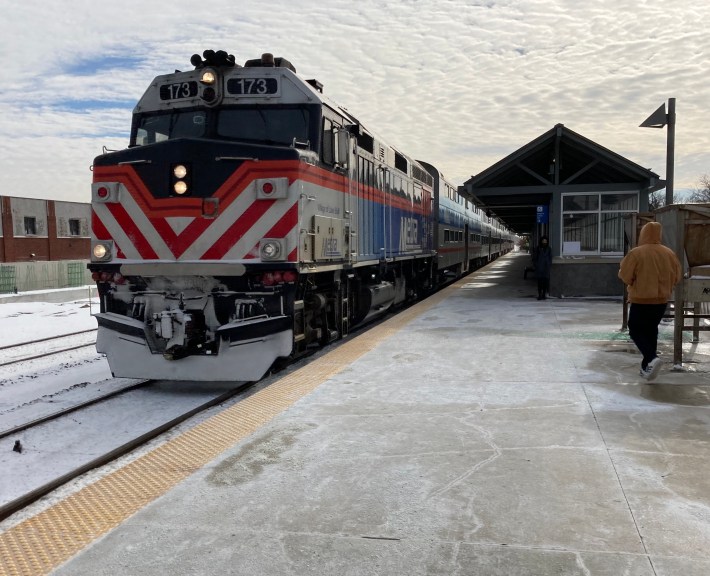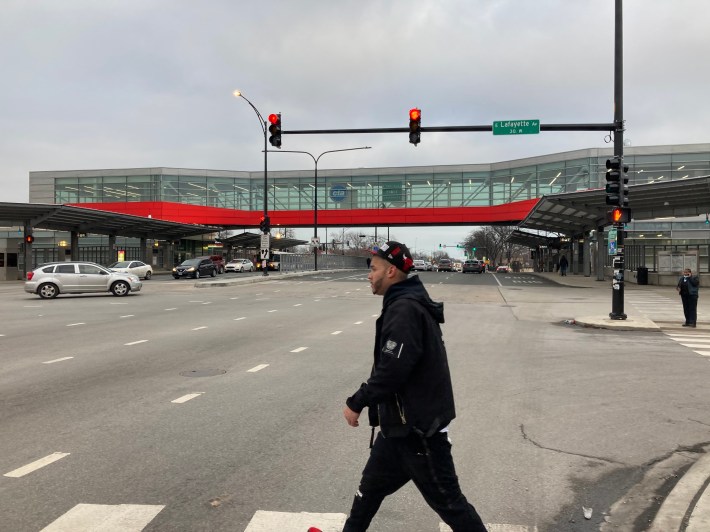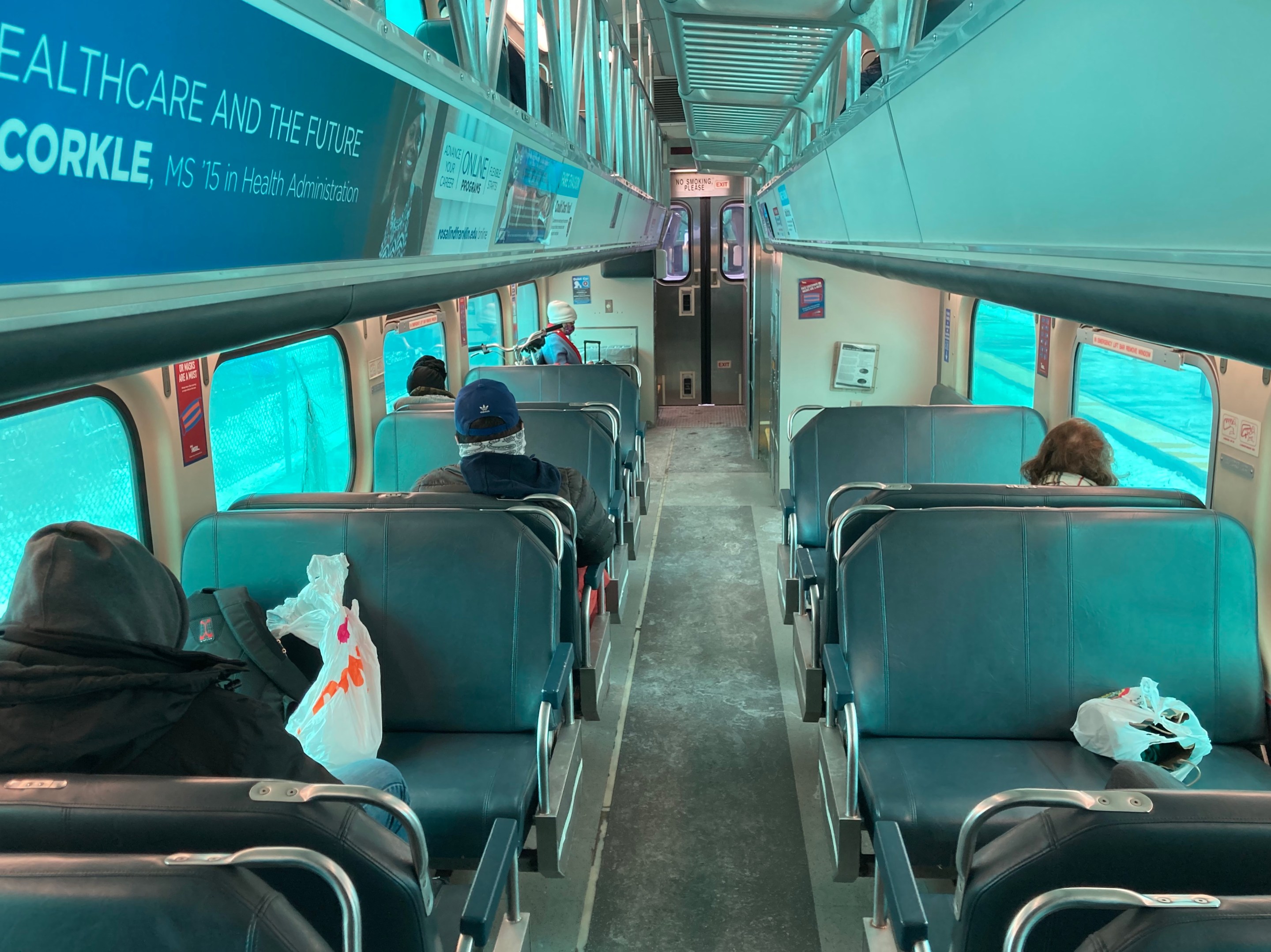In recent months I've heard reports that the ongoing feud between Metra and Union Pacific, which has an agreement with Metra to operates its UP North, Northwest and West lines, the three routes that terminate at the downtown Ogilvie Transportation Center, has been negatively impacting safety and quality of life on commuter trains.
Union Pacific has been using the COVID-19 pandemic as an excuse to not to have conductors collect fares from customers on the three lines, or even walk through the rail cars. Metra has said UP’s failure to collect fares is costing Metra $1 million a month. A railroad industry insider told Streetsblog Chicago that this recalcitrance is actually a strategy to “bleed Metra dry” in order to pressure it to pay to take over commuter rail operations for the three lines, of which UP owns the tracks and rolling stock.
Union Pacific filed a lawsuit to try to force a deal in December 2019, and Metra sued last summer in an effort to move the dispute from federal court to the U.S. Surface Transportation Board. In October Metra ratcheted the conflict up another notch with a new lawsuit accusing Union Pacific of breach of contract, arguing that UP is guilty of “severely damaging Metra’s bottom line, reputation and customer experience by an ‘arbitrary and capricious’ refusal” to have conductors collect fares and complete other onboard tasks.
Traditionally Metra trains have been viewed as safer, cleaner, and more orderly than the CTA 'L'. Conductors patrolling the cars on a regular basis discourages crime and problematic rule-breaking such as smoking and littering, which unfortunately seem to be fairly common on CTA trains nowadays. And, for better or for worse, in the past the higher fares on Metra trains have discouraged individuals experiencing homelessness from seeking shelter on Metra, and the conductors wouldn't have allowed people to sleep while lying across multiple aisle-facing seats, behaviors which are also widespread on the 'L'.
However, recently I've heard some reports that conditions on the Union Pacific-operated Metra lines have changed since they became more-or-less free to ride (although ticket checks are conducted at the Ogilvie Center) and the conductors stopped walking the cars. A friend of mine who was riding the UP-North line, which terminates in Kenosha, Wisconsin, every other week last fall, said mask wearing, which is officially compulsory on Metra, was hit-or-miss. He said there also appeared to be multiple unhoused people camped out on the trains, in some cases sleeping with their feet propped up on the seats.
He added that on one occasion people from the next car kept entering his carriage to yell at other riders, saying things like, "What are you doing here, [person from] Kenosha?" He suspected there might be a gang conflict at play, so he moved to a different car to be on the safe side.
This week a Streetsblog reader asked if I would recommend riding the train to Kenosha to go sightseeing, so I posted on social media to ask people about their recent experiences on the UP-North line. Here's some of the feedback I got on the UP-N and other Union Pacific-run lines.
- "Everyone wears a mask."
- "I have taken the 'free' Metra lines a bunch of times on weekends and they're never crowded."
- "A friend was mentioning yesterday that's she's been taking weekly trips on UP-NW [which terminates in Harvard, Illinois.] She said that mask compliance and social distancing were good."
- "I’ve ridden the UP-N three times off-peak within Evanston to Ogilvie and it was three people per car max. All masked. One 'noser' fixed his mask after he saw me looking."
- "In my experience there's a fair amount of people who don't wear masks. My Metra trip last week had probably four out of eight people in my car not wearing one (mostly due to eating or drinking on the train.) But it's not crowded so it's not that bad."
- "I take the UP-North from downtown to Ravenswood a workday or two a week. My experience is that everyone is masked. It is sparsely populated, and if you take it in off hours it should be even less populated."
- "People [on the three UP lines] mostly wear masks, but also no one does anything if someone walks through a car yelling, or (horribly) when I saw a drunk guy pee all over the vestibule." [That person must have been highly intoxicated, since the trains offer onboard restrooms.]
So, nothing too awful reported, except for that last bit. Active Transportation Alliance spokesperson spokesperson Kyle Whitehead said the advocacy group hasn't received any complaints from members about conditions on the Union Pacific lines recently. Regarding the Metra-UP beef, he previously told Streetsblog, "We urge Union Pacific and Metra to put the best interests of people — transit riders and workers — over profit in these ongoing negotiations.”
I asked Metra spokesperson Michael Gillis for his take on whether safety and quality of life has declined on the Union Pacific-operated lines during the pandemic. "We have received many complaints from customers who feel the absence of conductors on Union Pacific trains has resulted in behavior from other passengers that would not otherwise be allowed or tolerated," he said. "We maintain that the presence of conductors in the cars promotes civil behavior and adherence to rules by customers. We have asked UP repeatedly to resume walking the trains. UP’s own practices and procedures recognize that it is 'critically important that train [workers] make repeated passes through their assigned cars throughout the trip, in order to detect and observe medical emergencies, passengers needing assistance or information, the general orderly conduct of the train, and fare collection.'"
"We fully disagree with the way UP has been operating the three UP lines; its performance is undermining our overall message and marketing efforts to win riders back," Gillis added. "For all these reasons, Metra sued Union Pacific for breach of contract in October, and moved for a preliminary injunction to request that the court compel Union Pacific to resume walking the trains again for the safety of passengers. We hope the court will quickly rule in our favor."
In response to Gillis's comment, Union Pacific spokesperson Elizabeth Graham said, "Metra took responsibility for onboard passenger and public safety on the Metra trains Union Pacific operates nearly three years ago. We’ve repeatedly asked Metra to increase its police presence to address any commuter safety concerns, because we want Chicago commuters to feel safe and confident when they are using Metra's service. Since the beginning of the pandemic, Union Pacific has consistently prioritized the safety of its employees and passengers by asking its conductors to limit close-proximity contact with the public and to refrain from walking through trains."

While I recently had a good experience riding the UP-Northwest line to Arlington Heights to go shopping for Japanese groceries, I hadn't ridden the UP-North during COVID until this afternoon, when I checked out conditions during a trip to Lake Bluff. I walked through all the cars on both legs of my trip and never saw a conductor in the passenger carriages.
Mask compliance wasn't perfect, with maybe one-fifth of riders failing to cover their faces. Most of those people were sitting in lightly populated cars or on the upper level, or were eating or talking on the phone.
I noticed a couple of people traveling with bedrolls who appeared to be unhoused, something I don't recall seeing on Metra before. But they weren't breaking any rules or causing any problems for fellow riders. The trains were clean, and I certainly didn't witness anyone urinating in a vestibule. So the trip was fairly pleasant and uneventful, although it's possible that conditions are different at night.
That's in marked contrast with recent excursions I've taken on the CTA Red Line at various times of day. Mask compliance has been somewhat worse than on today's Metra trip, and smoking and littering have been rampant. It may be that the steep drop in ridership during the pandemic, which means fewer eyes on the trains, has made people bolder about breaking quality-of-life rules.

A trip I took from the Wilson station to the 95th/Dan Ryan terminal last week during the daytime was particularly wild. On the journey south, near Belmont Avenue a teen randomly slapped the back of my head and then cursed at me. I switched cars.
On the way home as we were about to depart 95th, a man stood inside the car urinating onto the platform, delaying the train. When he was finished, there was plenty of urine on the floor of the carriage as well. I glanced towards a woman on my end of the train, expecting to see a look of disapproval. Instead, she was calmly smoking a cigarette. I switched cars.
It's certainly way past time for Metra and Union Pacific to settle their differences, if only for fiscal reasons. But when it comes to quality of life on the trains, maybe Metra riders should count their blessings.






